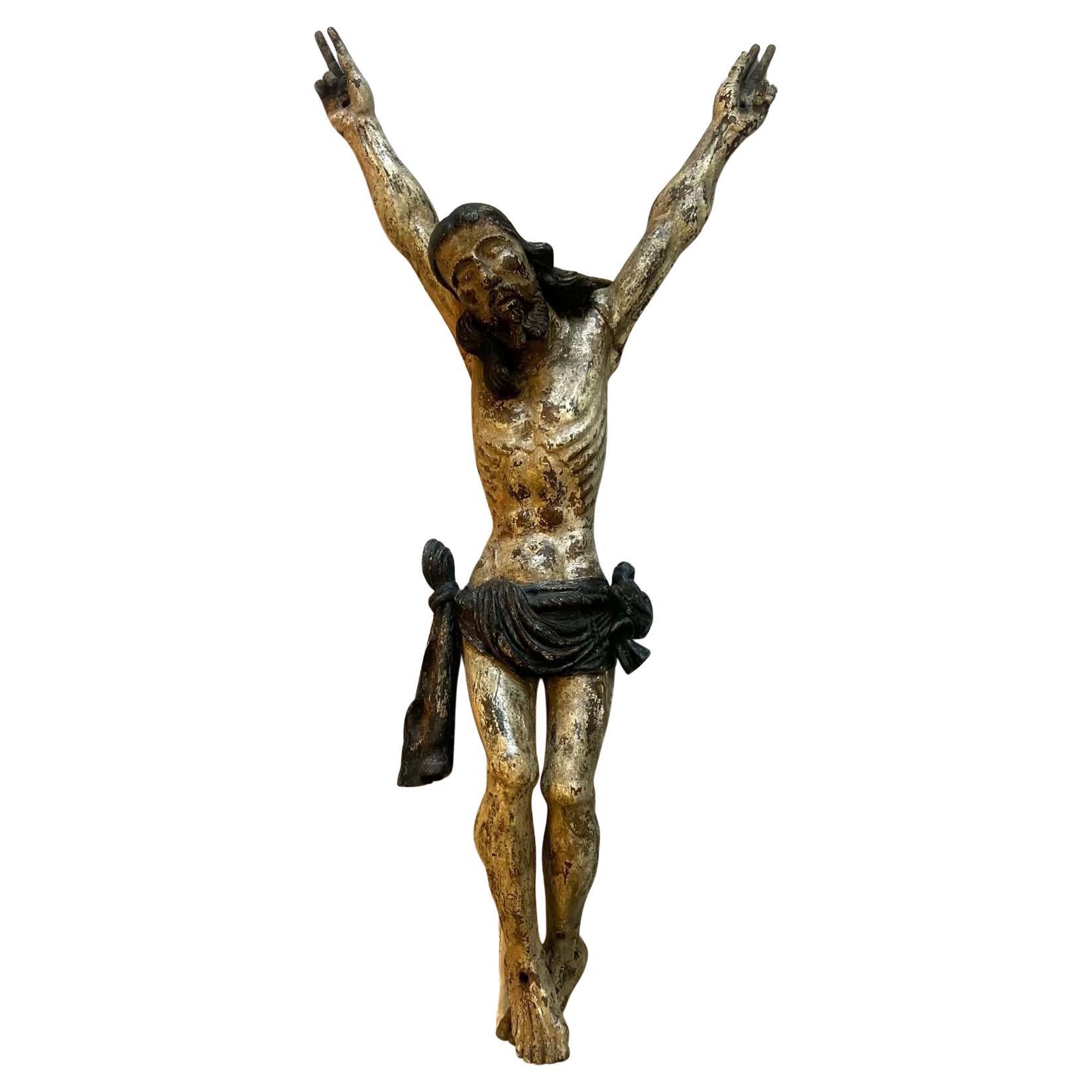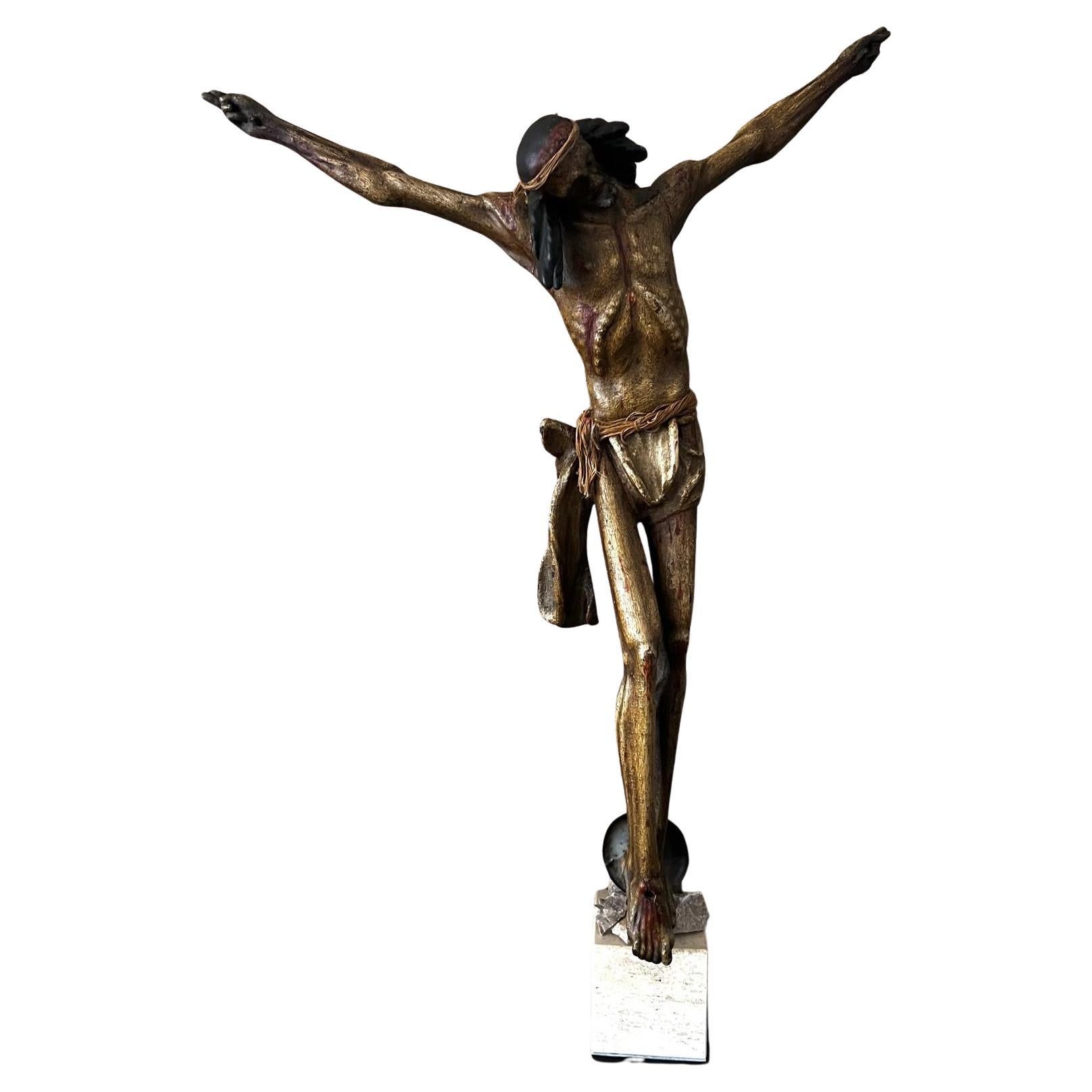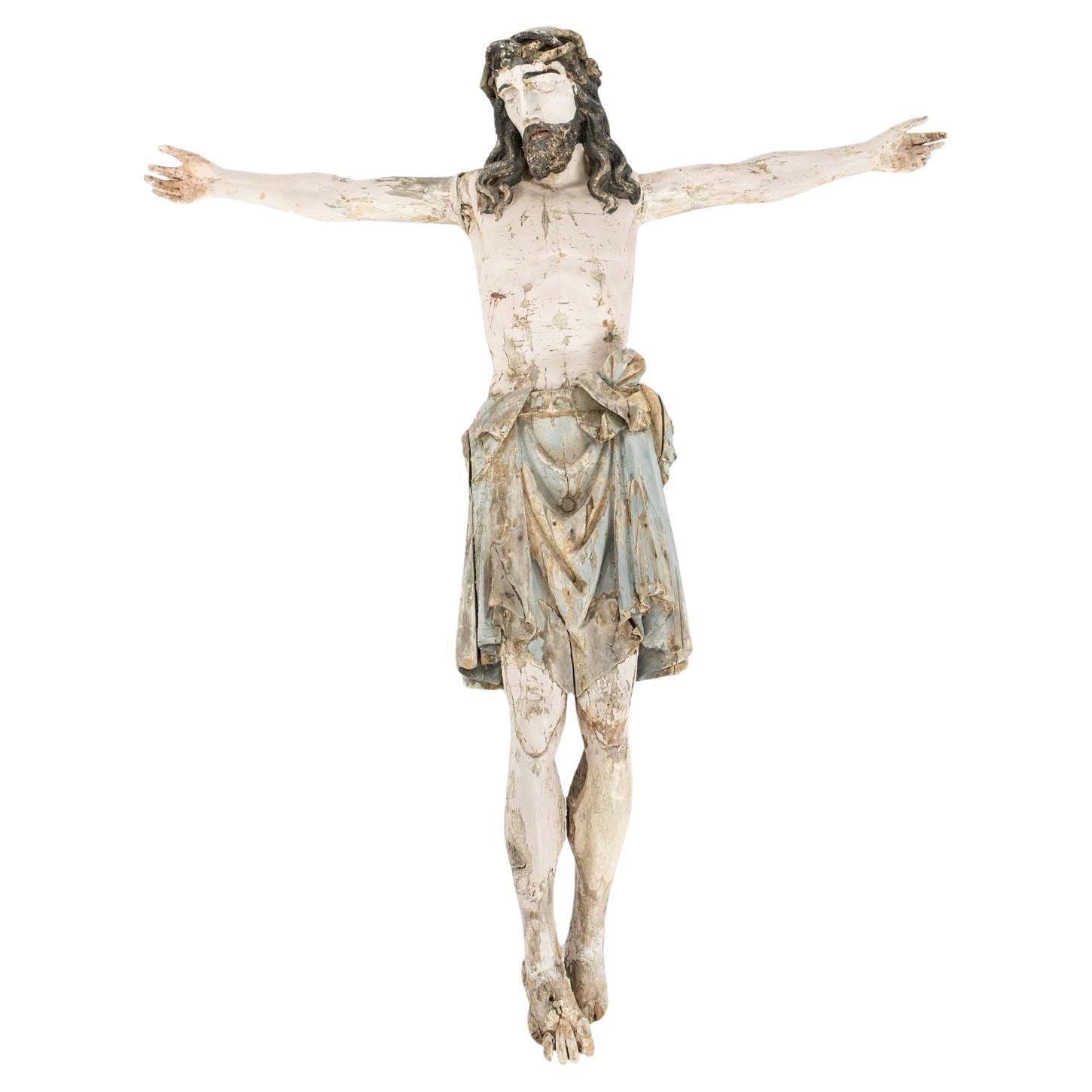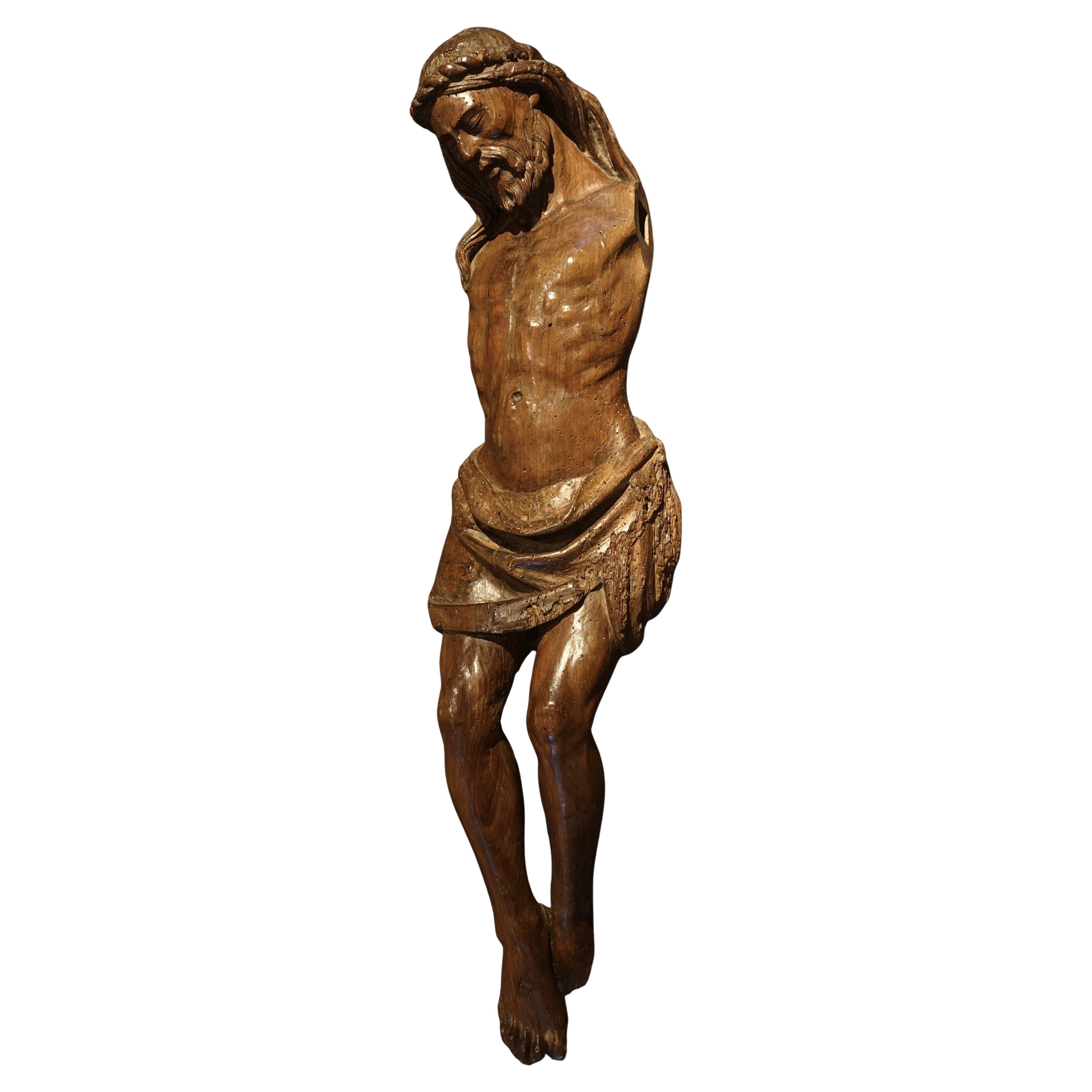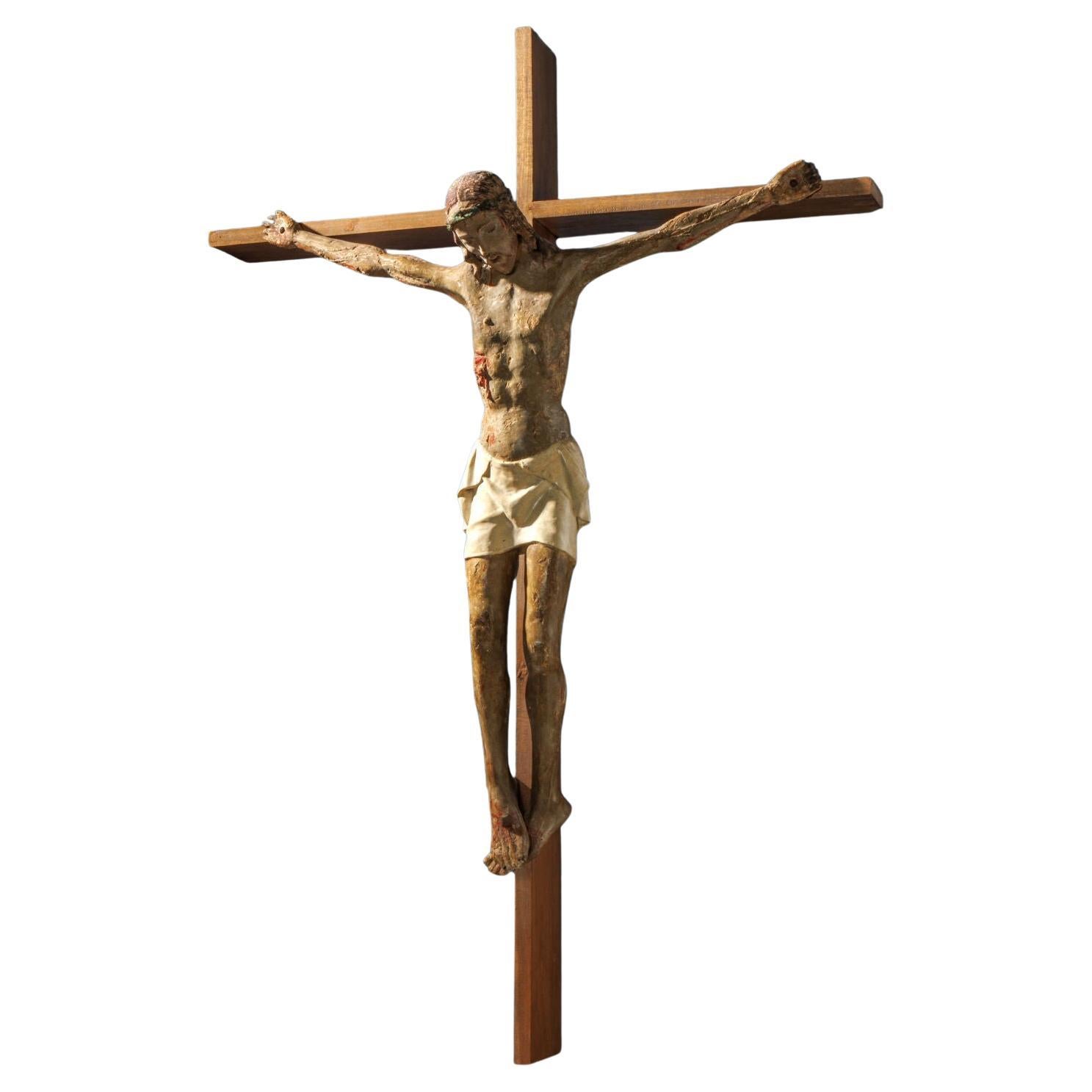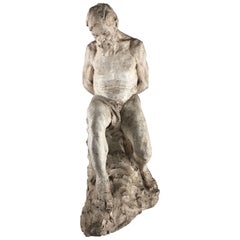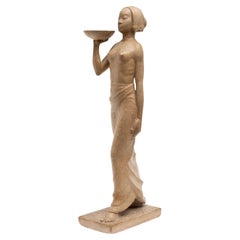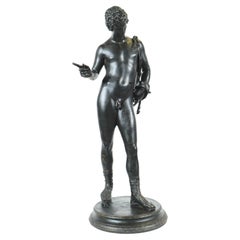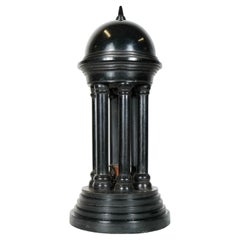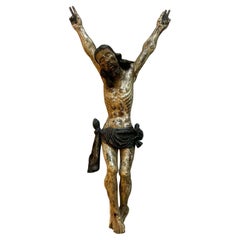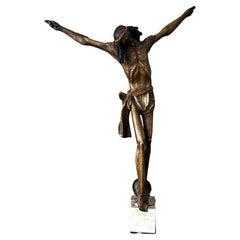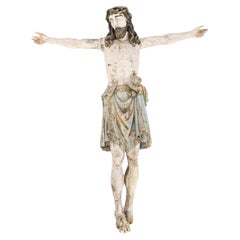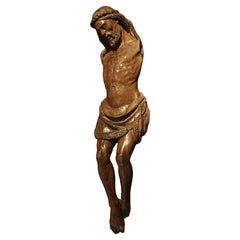Items Similar to 15th Century Corpus Christi Wood Sculpture
Want more images or videos?
Request additional images or videos from the seller
1 of 19
15th Century Corpus Christi Wood Sculpture
$13,829.43
£10,066.29
€11,500
CA$18,823.25
A$21,054.99
CHF 10,957.14
MX$259,194.14
NOK 139,397.55
SEK 130,782.38
DKK 87,517.50
Shipping
Retrieving quote...The 1stDibs Promise:
Authenticity Guarantee,
Money-Back Guarantee,
24-Hour Cancellation
About the Item
Rare late 15th century or early 16th century Gothic Corpus Christi wood sculpture. Probably North German or South Sweden. This large Christ sculpture has a worn beautiful original polychrome painted surface. It is a striking sculpture with Christ´s suffering clearly expressed. The way the rib cage is sculpted is very unusual. There is a Corpus Christi sculpture in the Historic museum of Stockholm with a similar treatment.
Sometimes relics where hidden in these sculptures and it is possible that there is a hidden space in our Christ on his left side where the ribs are. A lid looking piece with part of his ribs sculptured to be part of the rest is visible on the left side opposite his wound.
The depiction of Jesus hanging on a cross has roots dating back to 4th century Rome. Gothic art, which emerged in the 12th century, built on the foundations laid by Romanesque sculpture. The narrative focus and use of biblical symbolism continued to be central to Gothic art, but with a greater emphasis on realism and emotional expression than during the Romanesque period.
Gothic sculptors sought to depict figures and scenes with greater naturalism, a greater emphasis on emotional expression, with figures depicted in more dynamic and dramatic poses moving away from the more stylized forms of Romanesque art. The transition from Romanesque to Gothic art was a gradual one, with many of the same sculptors working in both styles, contributing to the development of a rich and diverse artistic tradition.
In the Romanesque crucifix, Christ has four nails, one in each hand and one in each foot with the legs depicted separated. During the Gothic period the four nails have been reduced to three, as the feet are now placed on top of each other and fastened with a single nail. The body hangs heavily to increase the feeling of pain and suffering for the viewer. One would feel spiritual movement and compassion at the sight of Christ's pain. The triumphant Christ has now instead become the sufferer.
We offer free shipping within EU. 2-5 weeks delivery.
We also ship to the US.
- Dimensions:Height: 48.43 in (123 cm)Width: 35.44 in (90 cm)Depth: 9.45 in (24 cm)
- Style:Gothic (Of the Period)
- Materials and Techniques:
- Place of Origin:
- Period:
- Date of Manufacture:15th century
- Condition:Repaired: There are some old restorations to a few fingers and the head has been off at some point. A small missing piece of the loincloth has been replaced. Wear consistent with age and use. Minor losses. Minor structural damages. Minor fading. For its type and age in good condition.
- Seller Location:Stockholm, SE
- Reference Number:1stDibs: LU1006843441182
About the Seller
4.9
Recognized Seller
These prestigious sellers are industry leaders and represent the highest echelon for item quality and design.
Established in 1989
1stDibs seller since 2013
107 sales on 1stDibs
Typical response time: 1 hour
- ShippingRetrieving quote...Shipping from: Stockholm, Sweden
- Return Policy
Authenticity Guarantee
In the unlikely event there’s an issue with an item’s authenticity, contact us within 1 year for a full refund. DetailsMoney-Back Guarantee
If your item is not as described, is damaged in transit, or does not arrive, contact us within 7 days for a full refund. Details24-Hour Cancellation
You have a 24-hour grace period in which to reconsider your purchase, with no questions asked.Vetted Professional Sellers
Our world-class sellers must adhere to strict standards for service and quality, maintaining the integrity of our listings.Price-Match Guarantee
If you find that a seller listed the same item for a lower price elsewhere, we’ll match it.Trusted Global Delivery
Our best-in-class carrier network provides specialized shipping options worldwide, including custom delivery.More From This Seller
View AllSculpture of Plaster, signed Gallé and dated -93 (1893)
Located in Stockholm, SE
A plaster sculpture by André Vauthier-Galle (1818–1899). A seated male figure with his hands behind his back. Executed in a very realistic way. The sculpture very much reminds of Auguste Rodins "The Thinker" in its pose.
The sculpture has a great patina.
The sculpture comes from the workshop of the Swedish painter and sculptor Jonas Åkesson...
Category
Antique 1890s French Figurative Sculptures
Materials
Plaster
$4,040 Sale Price
20% Off
Art Deco Sculpture of a Polynesian Woman
Located in Stockholm, SE
An art deco terracotta-painted plaster sculpture of a partly nude odalisque walking holding a tray, signed and dated "KA (19)15" by Swedish sculptor Knut Andersson (1884–1954). This ...
Category
Vintage 1910s Swedish Art Deco Figurative Sculptures
Materials
Plaster
Grand Tour sculpture of Narcissus, 19th c
Located in Stockholm, SE
This elegant 19th-century Grand Tour bronze sculpture represents Narcissus, the character from Greek mythology known for his beauty and self-admiration. Standing 65 cm high, the figu...
Category
Antique Mid-19th Century Italian Figurative Sculptures
Materials
Bronze
Wooden Roman temple. Grand Tour 19th c.
Located in Stockholm, SE
Grand Tour Roman Temple Souvenir – A Timeless Masterpiece in Blackened Wood.
Transport yourself to the grandeur of classical antiquity with this exquisite Grand Tour Roman Temple So...
Category
Antique 19th Century Italian Grand Tour Historical Memorabilia
Materials
Wood
19th Century Bronze Sculpture, Venus Callipyge, Grand Tour, Sommer Napoli
By Fonderia Sommer Napoli
Located in Stockholm, SE
A fine and rare Neapolitan Grand Tour bronze of the Venus Callipyge, after the original in National Archeological Museum of Naples. Signed Sommer, Napoli. An erotic bronze, the name ...
Category
Antique Late 19th Century Italian Grand Tour Figurative Sculptures
Materials
Marble, Bronze
Lead Pidgin, 18th Century Swedish
Located in Stockholm, SE
A rare lead pidgin that was used as a counterweight when hanging chandeliers. The pidgin was above the chandelier or lantern towards the roof. When candles were to be changed you pul...
Category
Antique 18th Century Swedish Gustavian Models and Miniatures
Materials
Lead
You May Also Like
Rare Antique Medieval Gothic Corpus Christi, Large, Untouched Museum Masterpiece
Located in Doha, QA
An extraordinary and museum-worthy 14th/15th century Gothic Corpus Christi, masterfully hand-carved in wood with exceptional anatomical detail and partially polychromed in white and ...
Category
Antique 15th Century and Earlier Austrian Gothic Figurative Sculptures
Materials
Wood
Antique 15th c. Gothic Italian Corpus Christi in Polychrome Wood, Hand-Carved
Located in Doha, QA
Exceptional 15th Century Polychromed Wood Crucifix Sculpture from Northern Italy
This rare and exquisite 15th-century hand-carved Corpus Christi is a true masterpiece of devotional a...
Category
Antique 15th Century and Earlier Italian Gothic Figurative Sculptures
Materials
Stone, Marble
Italian 18th Century Hand-carved Corpus Christi in Original Paint
Located in Houston, TX
Italian 18th century hand-carved Corpus Christi, in original paint, or in some small areas early paint.
Note: Original/early finish on antique a...
Category
Antique Mid-18th Century Italian Baroque Figurative Sculptures
Materials
Gesso, Wood, Paint
Christ - Umbria, second half of the 15th century
Located in Bruxelles, BE
Christ
Umbria, Orvieto?
Second half of the 15th century
77 x 16.5 cm
Category
Antique 15th Century and Earlier Italian Renaissance Figurative Sculptures
Materials
Walnut
Corpus Wood Polychrome Antique Christi 18th Century Sculpture Image 33cm
Located in Poperinge, BE
Beautiful antique wooden Corpus Christi (body of Christ) statue, sculpture, from around the beginning of the 18th century probably Flemish
Beautiful wood carving and polychrome (pai...
Category
Antique Late 18th Century Belgian Figurative Sculptures
Materials
Gesso, Fruitwood
Christ Crucified Tuscany c. 1470-1480.
By Non-Standard Furniture and Lighting
Located in Milano, IT
Polychrome wooden sculpture depicting Christ Crucified, with emaciated limbs and head reclining on the chest; the body is painted with an earthy hue, around the hips a loincloth that...
Category
Antique 15th Century and Earlier Italian Other Figurative Sculptures
Materials
Wood
$8,129 Sale Price
20% Off
More Ways To Browse
16th Century Antiques
Romanesque Furniture
Romanesque Style
16th Century Cross
Gothic German
Carved Wood Jesus
Wood Crucifix
Antique Crosses Crucifixes
German Wood Carved Figures
Body Of Christ
Carved Crucifix
Polychrome Jesus
Wood Carved Crucifix
Hand Carved Wood Crucifix
Large Crucifix
Corpus Crucifix
Corpus Of Christ
Antique Corpus Christi
